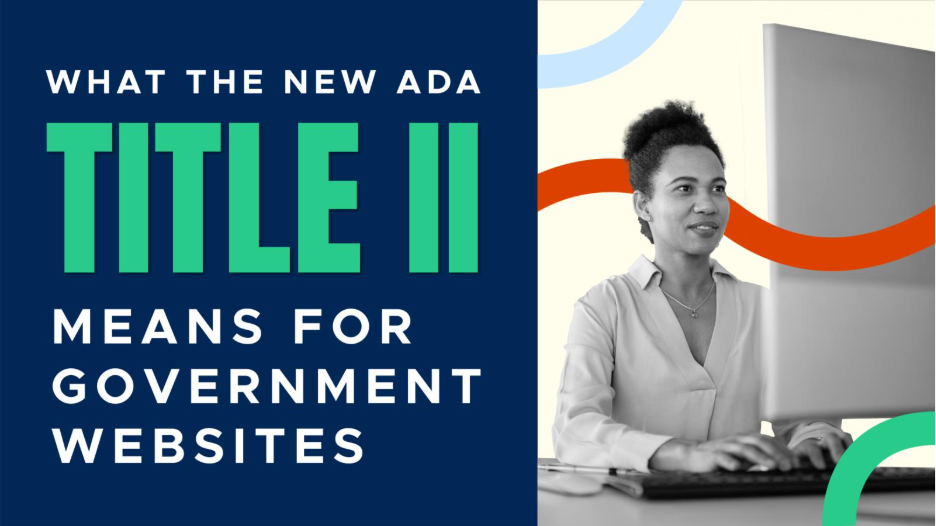blog
What the New ADA Title II Rule Means for Government Websites and How to Prepare
What the New ADA Title II Rule Means for Government Websites and How to Prepare

Have you heard about the new ADA Title II update introduced in April 2024 and what it means for your website? The rule sets clear accessibility requirements with firm deadlines for public websites.
You may have planned to address accessibility gradually, but the new compliance timelines make it important to start preparing now. Federal oversight of digital accessibility is increasing, and public websites are now expected to meet defined standards.
Title II requires compliance with WCAG 2.1 AA by April 24, 2026, for public entities serving 50,000 or more people, and by April 26, 2027, for those serving fewer than 50,000. The rule elevates WCAG from a guideline to a legal standard, making compliance non-negotiable.
This article outlines the changes and provides steps to prepare for compliance.
Why Government Websites Must Meet Digital Accessibility Standards
Digital accessibility is now a legal requirement. This change reflects a broader movement toward inclusion, ensuring every resident can access essential public services online. To understand how this shift affects you, it helps to look at the impact of the DOJ’s rule.
How the DOJ ADA Title II Rule Impacts Government Websites
The Department of Justice’s (DOJ) new rule sets clear expectations:
- The rule makes digital accessibility a legal requirement for public agencies
- Government websites and apps must follow WCAG 2.1 AA standards
- Residents with disabilities gain equal access to vital services online
- Public entities now face enforceable deadlines with no ambiguity
This update removes uncertainty and requires agencies to act now to avoid last-minute pressure.

2024 ADA Title II Update What Changed for Government Websites
For years, accessibility guidance lacked clarity and left agencies uncertain. The April 2024 update changed that by giving state and local governments a clear framework and enforceable deadlines.
Title II Accessibility Requirements for State and Local Governments
Title II applies directly to state and local governments as well as special districts. It requires agencies to make all services, programs, and activities accessible, including digital content such as websites, documents, and online services.
Scope of the April 2024 ADA Title II Rule
The rule goes a step further by:
- Officially adopting WCAG 2.1 AA as the digital accessibility standard
- Introducing clear deadlines based on population size
- Covering websites, mobile apps, and other online services
These updates define both the standards and the compliance timelines.
WCAG 2.1 AA Standards for ADA Title II Compliance
WCAG 2.1 AA is a practical framework for public agencies because it balances usability and effort.
What WCAG 2.1 AA Guidelines Cover
WCAG is internationally recognized as a framework for accessible design. Level AA strikes a balance between usability and effort, making it widely achievable for most agencies.
Best Practices to Meet WCAG 2.1 AA for Government Websites
Meeting WCAG 2.1 AA means putting accessibility into practice every day:
- Add alt text for meaningful images
- Include captions and transcripts for audio and video
- Maintain readable font sizes and high color contrast
- Build pages that work with keyboard-only navigation
- Structure content clearly to improve comprehension
These practices create a better digital experience for all residents, not just those with disabilities.
Content That Must Be Accessible Under ADA Title II
Agencies must know which types of content fall under the rule, with public-facing materials as the priority.
Public-Facing Content That Requires Accessibility
Your agency must ensure accessibility across:
- Websites and web apps (portals, forms, maps)
- PDFs and document files (Word, PowerPoint, Excel)
- Mobile apps offered by your agency
- Videos, livestreams, and image-based social media posts
Third-Party Platforms and Tools Accessibility Requirements
The responsibility does not stop with your own content. Platforms and widgets used for public services must also meet WCAG 2.1 AA. Even if vendors host the content, you remain accountable for accessibility.

ADA Title II Content Exemptions
Not all content falls under the new rule. The DOJ outlined a handful of specific exceptions that allow some flexibility.
Four ADA Title II Exemptions
- Archived web content
- Third-party user content
- Password-protected individual documents
- Older social media posts
Limited Defenses Undue Burden and Fundamental Alteration
Agencies must use exemptions sparingly, document them, and provide accessible alternatives when requested.
ADA Title II Compliance Deadlines 2026 and 2027 Requirements
The timeline you follow depends on the size of the population your entity serves. This phased approach allows smaller entities more time to prepare.
2026 Deadline for Large Government Entities
This deadline applies to states, counties, and municipalities serving 50,000 or more people.
2027 Deadline for Small Entities and Special Districts
Local governments serving fewer than 50,000 people and special districts must meet accessibility requirements by 2027.
These deadlines give every entity a firm target, making early action important.
How to Start ADA Title II Compliance for Your Website
With standards and timelines defined, the next step is getting started. Breaking the work into manageable steps helps agencies move forward with confidence.
First Steps to Achieve ADA Title II Compliance
- Audit top pages and user pathways for accessibility gaps
- Update shared templates to improve accessibility sitewide
- Fix or replace forms and workflows used most often
- Train content editors to use alt text, headings, and accessible link text
- Include WCAG 2.1 AA language in RFPs and vendor contracts
Each step builds a foundation for compliance. Agencies that act now will avoid the stress of looming deadlines.

Partner with Legend to Make Your Website ADA Title II Compliant
You do not have to manage this process alone. At Legend, our website platform (Model 6 and forward) is built to meet WCAG 2.1 accessibility standards. Our developers designed the structure, navigation, and core features to support compliance from the start, including screen reader compatibility, keyboard navigation, and adaptable content layouts.
We also monitor ADA updates. If new guidelines are released, we notify clients and provide any required updates or patches, along with estimates where applicable. During onboarding, we train your staff to manage accessible content, so your images, videos, and documents also meet accessibility expectations.
With nearly 25 years in business and more than 15 years of experience serving public agencies, we know how to achieve compliance efficiently. Our standard build timeline is 16 to 20 weeks, so beginning early helps you stay ahead of deadlines and avoid last-minute stress.
Schedule a meeting with Legend today to get your WCAG 2.1 AA audit and a prioritized fix plan in motion.

